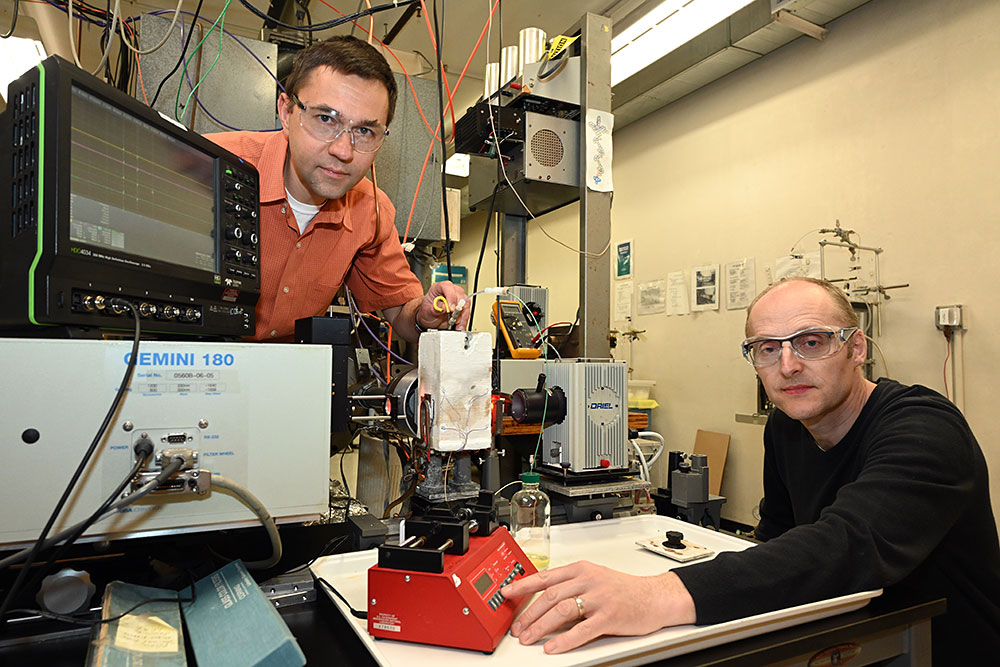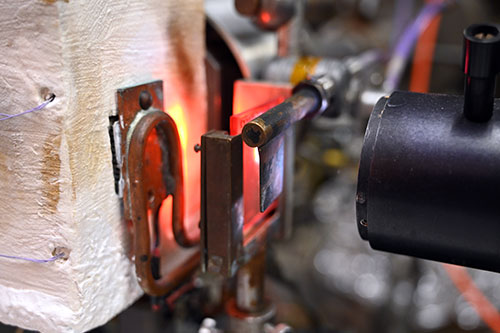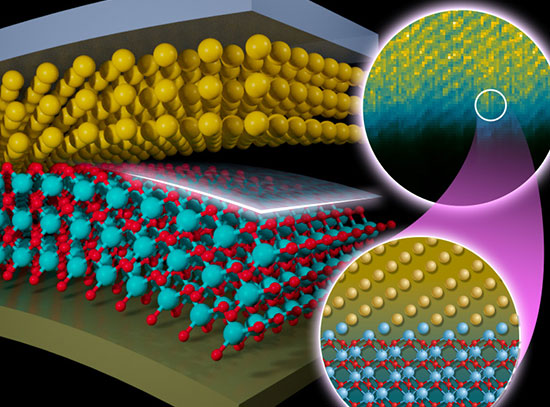Chemists Unravel Reaction Mechanism for Clean Energy Catalyst
Pulse radiolysis experiments at Brookhaven Lab revealed rapid reactivity that has never been observed before
May 15, 2023
 enlarge
enlarge
Dmitry Polyansky (left) and David Grills in the pulse radiolysis lab where the research was conducted. Here, Grills programs a syringe pump that delivers the catalyst to the radiolysis cell. Polyansky adjusts the radiolysis cell inside a white insulated compartment.
UPTON, NY—Hydrogen, the simplest element on Earth, is a clean fuel that could revolutionize the energy industry. Accessing hydrogen, however, is not a simple or clean process at all. Pure hydrogen is extremely rare in nature, and practical methods to produce it currently rely on fossil fuels. But if scientists find the right chemical catalyst, one that can split the hydrogen and oxygen in water molecules apart, pure hydrogen could be produced from renewable energy sources such as solar power.
Now, scientists are one step closer to finding that catalyst. Chemists at the University of Kansas and the U.S. Department of Energy’s (DOE) Brookhaven National Laboratory have unraveled the entire reaction mechanism for a key class of water-splitting catalysts. Their work was published today in Proceedings of the National Academy of Sciences (PNAS).
“It’s very rare that you can get a complete understanding of a full catalytic cycle,” said Brookhaven chemist Dmitry Polyansky, a co-author of the paper. “These reactions go through many steps, some of which are very fast and cannot be easily observed.”
 enlarge
enlarge
Scientists use this "probe" light from a xenon lamp to monitor their catalyst solution for chemical changes initiated by pulses of electrons.
Rapid intermediate steps make it difficult for scientists to decipher exactly where, when, and how the most important parts of a catalytic reaction occur—and therefore, if the catalyst is suitable for large-scale applications.
At the University of Kansas, associate professor James Blakemore was researching possible candidates when he noticed something unusual about one catalyst in particular. This catalyst, called a pentamethylcyclopentadienyl rhodium complex, or Cp*Rh complex, was demonstrating reactivity in an area where molecules are usually stable.
“Metal complexes—molecules that contain a metal center surrounded by an organic scaffold—are important for their ability to catalyze otherwise difficult reactions,” said Blakemore, who is also a co-author of the paper. “Typically, reactivity happens directly at the metal center, but in our system of interest, the ligand scaffold appeared to directly take part in the chemistry.”
So, what exactly was reacting with the ligand? Was the team really observing an active step in the reaction mechanism or just an undesirable side reaction? How stable were the intermediate products that were produced? To answer questions like these, Blakemore collaborated with chemists at Brookhaven Lab to use a specialized research technique called pulse radiolysis.
Pulse radiolysis harnesses the power of particle accelerators to isolate rapid, hard-to-observe steps within a catalytic cycle. Brookhaven’s Accelerator Center for Energy Research (ACER) is one of only two locations in the United States where this technique can be conducted, thanks to the Lab’s advanced particle accelerator complex.
“We accelerate electrons, which carry significant energy, to very high velocities,” said Brookhaven chemist David Grills, another co-author of the paper. “When these electrons pass through the chemical solution we’re studying, they ionize the solvent molecules, generating charged species that are intercepted by the catalyst molecules, which rapidly alter in structure. We then use time-resolved spectroscopy tools to monitor the chemical reactivity after this rapid change occurs.”
Spectroscopic studies provide spectral data, which can be thought of as the fingerprints of a molecule’s structure. By comparing these signatures to known structures, scientists can decipher physical and electronic changes within the short-lived intermediate products of catalytic reactions.
“Pulse radiolysis allows us to single out one step and look at it on a very short timescale,” Polyansky said. “The instrumentation we used can resolve events at one millionth to one billionth of a second.”
By combining pulse radiolysis and time-resolved spectroscopy with more common electrochemistry and stopped-flow techniques, the team was able to decipher every step of the complex catalytic cycle, including the details of the unusual reactivity occurring at the ligand scaffold.
“One of the most remarkable features of this catalytic cycle was direct involvement of the ligands,” Grills said. “Often, this area of the molecule is just a spectator, but we observed reactivity within the ligands that had not yet been proven for this class of compounds. We were able to show that a hydride group, an intermediate product of the reaction, jumped onto the Cp* ligand. This proved that the Cp* ligand was an active part of the reaction mechanism.”
Capturing these precise chemical details will make it significantly easier for scientists to design more efficient, stable, and cost-effective catalysts for producing pure hydrogen.
The researchers also hope their findings will provide clues for deciphering reaction mechanisms for other classes of catalysts.
“In chemistry, findings like ours can often be generalized and applied to optimize other systems, but obtaining critical details on rapid reactivity, like we have done here, is a key step,” Blakemore said. “We hope other research groups will take our insights and build on them, perhaps by using ligand-promoted reactivity to build better catalysts.”
This study is just one set of experiments among a large body of clean energy work that scientists at the University of Kansas and Brookhaven Lab are conducting.
“We’re building the fundamental chemical knowledge that will, one day, help scientists design the optimal catalyst for producing pure hydrogen,” Polyansky said.
This work was supported by the National Science Foundation and the DOE Office of Science.
Brookhaven National Laboratory is supported by the Office of Science of the U.S. Department of Energy. The Office of Science is the single largest supporter of basic research in the physical sciences in the United States and is working to address some of the most pressing challenges of our time. For more information, visit science.energy.gov.
Follow @BrookhavenLab on Twitter or find us on Facebook.
2023-21150 | INT/EXT | Newsroom









